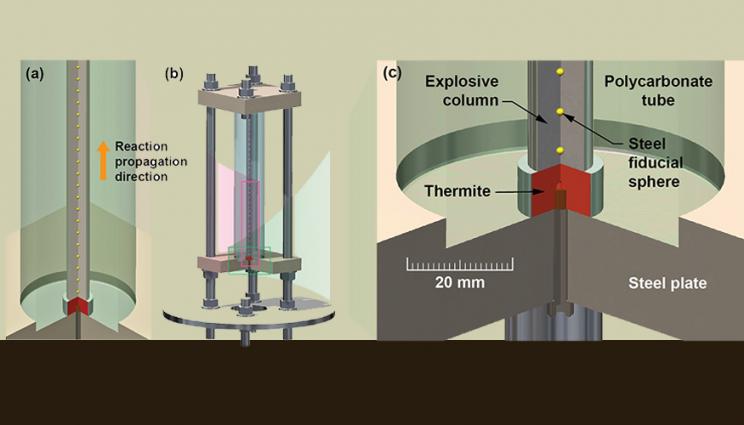
By packing porous explosive powder in clear polycarbonate tubes and observing the explosions with X-ray imaging and high-speed cameras, Lawrence Livermore and Los Alamos national laboratory researchers have revealed key insights about the transient phenomena that occurs during the deflagration-to-detonation transition process. The findings will help improve understanding of explosives to make them safer for handling, storage and transportation.
On Aug. 4, 2020, a massive explosion rocked Lebanon's capital of Beirut, sending shockwaves through the city and shattering windows, reducing some buildings to rubble and killing at least 200 people. Officials have since traced the blast to a stockpile of more than 2,500 tons of confiscated ammonium nitrate stored in a port warehouse.
While the official investigation is ongoing, it appears the explosion was caused by a fire in the warehouse that ignited the highly combustible chemical, which subsequently detonated. Scientists call this a "deflagration-to-detonation transition" or DDT, but many mysteries remain about the mechanisms responsible for the phenomenon. New research by Lawrence Livermore National Laboratory (LLNL) and Los Alamos National Laboratory (LANL) is shedding light on the process and improving scientists' understanding of explosives to make them safer for handling, storage and transportation.
By packing porous explosive powder in clear polycarbonate tubes and observing the explosions in LLNL's High Explosives Application Facility with X-ray imaging and high-speed cameras, researchers have revealed key insights about the transient phenomena that occurs during the DDT process. The work appears in the Journal of Applied Physics.
"We were able to image this DDT transition process as it happened with both light and X-rays at the same time," said principal investigator and LLNL engineer Joe Tringe. "We characterized the three-dimensional nature of the process using a surrogate for damaged explosives. We think our observations will be important to help predict when and under what circumstances these transitions might happen in the future. While our research doesn't overturn previous theories of how the process works, it provides a new way of understanding this process that was previously inaccessible."
The DDT phenomenon has been difficult for scientists to study, in part because it requires the explosion to be confined, Tringe explained. Typically, the explosive is put in stainless steel confinement tubes, with windows or optical fibers installed for observation. By making the tube transparent, the researchers could watch in 3D as the DDT transition occurred in a pure explosive powder and in a plastic-bonded explosive called LX-14. With high-speed cameras, the team was able to capture where the explosives burned and used the X-rays to see the subtle formation of a "plug," where the powder compacts and becomes dense.
Marker structures for X-rays in the polycarbonate tubes showed explosive displacement prior to detonation and a plug forming around the burning explosive. Researchers observed the explosive burning rate accelerating and bypassing the plug just prior to detonation. The team also saw the tube expand due to increased internal pressure just before detonation and determined the explosive plug itself to be asymmetric, a result of phenomena that had never been characterized before.
"Throughout the previous decades, experimental results from many research groups have been interpreted differently and the mechanisms derived for DDT have been debated. In many instances, each group in the debate put forth plausible interpretations because there was often ambiguity in the older data records," said LANL's High Explosives Thermal and Mechanical Response Team leader and paper co-author Gary Parker. "The methods employed in this work, however, provide us with insight into how certain elements of the process evolve and these new observations should help settle some of the debate within our community. We look forward to exploring the impact and breadth of applicability of this new avenue in DDT research."
In addition to expanding general understanding of the DDT process, Tringe said the research could improve computational models of what happens in a nuclear weapon or any kind of solid explosive or propellant. Researchers will next turn their attention to probes that will penetrate metal to further investigate how this DDT phenomenon develops in steel tubes and higher confinement environments.
"We have to get more creative now," Tringe said. "We don't know if this phenomenon is only happening under light confinement or if it happens under more extreme conditions. It's an open question."
The National Nuclear Security Administration's Nuclear Safety R&D program funded the research, in addition to the LANL High Explosive Science Campaigns.
"To ensure safe nuclear explosive operations during severe accident scenarios, it is critical to understand the physics behind explosive ignition, pressurization and deflagration phenomena," said LLNL Initiation Systems Group Leader and Nuclear Safety R&D Lead Christopher Robbins. "Joe Tringe and his team have implemented diagnostics to provide unprecedented insight into how the high-explosive response evolves in various environments. This research has enhanced our understanding of high explosive physics as well as informed and validated our model predictions supporting nuclear explosive safety."
The interdisciplinary team included co-authors at LLNL David Stobbe, Martin De Haven, Aaron Ruch, Bradley White, John Reaugh and Kevin Vandersall. LANL's Parker, Laura Smilowitz, Matthew Holmes, Larry Vaughn and Bryan Henson assisted with experimental design and analysis.






